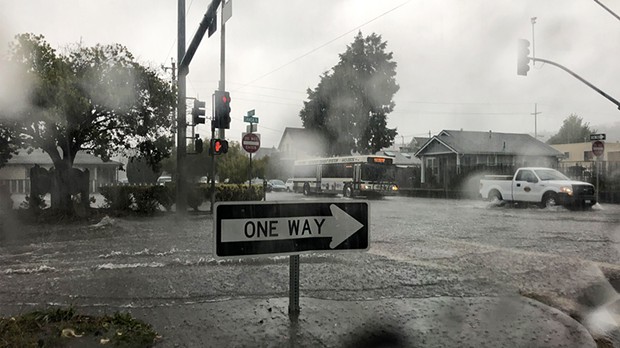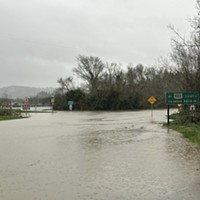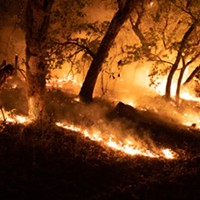[
{
"name": "Top Stories Video Pair",
"insertPoint": "7",
"component": "17087298",
"parentWrapperClass": "fdn-ads-inline-content-block",
"requiredCountToDisplay": "1"
}
]
If you think the government is going to bail you out if a flood comes, think again. While a dozen or so public agencies will do their darndest to save your life and maybe even your house, once the disaster is over, you are largely on your own.
If you are a homeowner, you probably know that "acts of God" are not covered by your standard insurance policy. What you may not have realized is that public agencies, from FEMA on down, are not allowed to gift public funds to private parties. In other words, unless it is a huge national-scale disaster, nobody is going to pay for your ruined private road if the culverts blow out or your ruined pasture if a levee fails. FEMA may help pay for the reconstruction of a hospital, school or highway, but not a subdivision.
"Public assistance is for public entities, public infrastructure," Dorie Lanni, Emergency Services manager for the Humboldt County Office of Emergency Services (OES), said at a consortium of disaster preparedness agencies held at the county agricultural building Sept. 17. "There is a misconception among the general public that government entities are going to assist them with damage to their private property and impacts to privately owned roads. Individual assistance ... for private property has a very high threshold, and it's very difficult for Humboldt County to meet that threshold."
Even if you want to protect your creek side home with sandbags, you are expected to purchase the bags in advance from a hardware store and buy the sand to fill them from a contractor. Public agencies are not supposed to hand these materials out.
These facts, along with many other aspects of flood awareness, were explained at the consortium by Lanni and Todd Flackus of the California Department of Water Resources (DWR). The discussion came the day before a Sept. 18 storm that dumped 2 inches of rain in less than an hour, causing some localized flooding in Arcata and underscoring the fact that winter is on its way.
Numerous public agencies are involved in the fight to protect communities from rising waters, including the California Conservation Corps, Calfire supervised "offender" crews from the prison system and the state Office of Emergency Services. They are integrated in a tight hierarchy of command that extends from FEMA to the sheriff's office.
"Before flood season comes, clean out your culverts," Lanni urged. "If you live on a private road, you are responsible for maintaining that. Or you've got a hill sliding down into your driveway. There is no assistance for that."
Lanni described the numerous tasks her agency performs — public information, ordering evacuations and, most importantly, coordinating with other agencies and asking the state for help when a disaster overwhelms the county's limited resources.
OES posts warnings on television and radio when a disaster is immanent but you can also choose to be automatically notified about tsunamis, dam failures or severe storms by a text message, email, landline message or a mobile app. (To sign up, visit www.humboldtgov.org/2014/Emergency-Notifications/alerts.)
Lanni said that in the event of a major disaster, audio warnings would also be delivered by the Civil Air Patrol through overhead flights but added, "People generally can't understand the words but it alerts them that something is happening."
"If there are actual evacuations, then we might be knocking on doors," she said.
California Conservation Corps project manager Peter Luvaas said CCC crews, which typically clear trails, fight fires and take on other public service tasks, are also ready to deploy should disaster strike. Luvaas said each of the corps' members — young adults from 18 to 25 — goes through the DFW flood-fighting course, regardless of assignment.
"Since 1977, we've filled more than 3 million sandbags," he said, adding that the CCC has flood defense materials stockpiled at its Fortuna center.
"We have crews everywhere," Luvaas continued. "We have one in Crescent City, one down by Leggett, one on the Avenue of the Giants. Those crews can be contacted and re-directed at any time for emergency response. We can work on public or private lands. We are self-contained. We can do 24-hour work schedules. If we need to camp somewhere, we're equipped to do that. We have very experienced supervisors who have worked in a variety of emergency conditions. ... We're glad to do whatever we can."
Another type of boots-on-the-ground assistance is offered by Calfire. In the summer, its prison inmate crews — locally stationed in three conservation camps in Humboldt and Del Norte counties — help fight fires and they are available for flood control in the winter.
"Crew members receive training at Susanville in firefighting and other emergency responses before being assigned to one of the camps," said Calfire Humboldt/DelNorte Unit Chief David Esteves. "DWR provides two weeks of training for fire captains who are going to go to a camp facility. They teach our captains how to supervise crews doing sandbagging and levee repair — putting that Band-Aid on until the water lowers."
Noting that the local CCC currently has 10 engines en route back from 11 days fighting fires in Tehama Glen, Esteves said his crews are ready to jump into action.
"We have heavy equipment," he said. "We have mobile communication centers. We have a mobile kitchen that can immediately feed up to 500 people and then extend out into the thousands, depending on the resources that we get. We have an air tanker and a helicopter based out of Kneeland. We have two bulldozers and six heavy equipment operators.
"We're the people who provide the boots on the ground. We're the people that are going to be passing sandbags, filling sandbags and putting people into that flood area."
The Humboldt County Department of Public Works is tasked with removing fallen trees and power lines from roadways, while Caltrans does the same for state highways.
Todd Flackus of the Eureka Flood Center, a local subsidiary of the Department of Water Resources, said his job includes training flood-fighters, issuing river forecasts and supplying flood-fighting materials to other agencies when needed.
Filling sandbags is labor-intensive and requires a large number of people who know how to align and stack the bags to keep water out.
"A bale of sandbags weighs 550 pounds," he remarked.
But Flackus said those sand bags aren't passed out to locals to protect private property. For that, he suggested contacting local hardware stores, urging residents to monitor rising river stages in real time and reaching out for supplies before flooding begins.
"We're not issuing supplies to individuals so they can barricade their driveway," said Flackus. "We protect utilities, infrastructure, hospitals, water treatment plants."
Humboldt County has between 20 and 40 miles of levees, depending on whose count you use. While some protect seaside communities from the ocean, many protect inland areas from the Mad, Klamath and Eel rivers, as well as Redwood Creek. These river levees were built by the U.S. Army Corps of Engineers, Lanni noted, but the corps no longer owns or takes responsibility for them.
Nobody knows who does, Flackus said, adding that they see very little maintenance and some are covered with blackberry bushes and willows, making them hard to reinforce during an emergency.
"Some of these levees are so covered with vegetation that you can't even see them," observed one official. "Waiting until the 11th hour when the rivers are rising is too little, too late."
National Weather Service meteorologist Kathleen Zontos reminded that the region saw significant flooding last February.
"There was flooding in Ferndale and Loleta," she said. "This was one of the most significant floods we've had in the past 10 years. It was No. 5 of all time records for the Eel River and for Fernbridge."
Zontos cautioned that the National Weather Service does not know what to expect during the coming winter.
There is, however, some good news on the front to combat flooding of a different sort. The California Coastal Commission has offered the county a $100,000 grant to coordinate planning among the myriad of agencies, private landowners and companies that own dikes along Humboldt Bay. Such coordination should make dike inspection and repair easier, and is hoped to add to the long-term protection of the area from sea level rise. The board of supervisors unanimously approved the grant application at its Sept. 17 meeting.
During the supervisors' meeting a couple of weeks earlier, county Planning Director John Ford said the California Coastal Commission seems to be undergoing a shift and appears less resistant to efforts to protect the shoreline.
"Their traditional [standard] has always been the Coastal Act," said Ford, "but the Coastal Act was written before sea level rise was a reality."
Elaine Weinreb is a freelance journalist and prefers she/her pronouns. She tries to repay the state of California for giving her a degree in environmental studies and planning (Sonoma State University) at a time when tuition was still affordable.
Speaking of...
more from the author
-
Trouble on the Mountain
A popular outdoor recreation area is also a makeshift shooting range, causing growing safety concerns
- Jan 11, 2024
-
Port of Entry
Harbor District begins environmental review for project to turn Humboldt Bay into a wind farm manufacturing hub
- Jul 27, 2023
- More »
Latest in News
Readers also liked…
-
Through Mark Larson's Lens
A local photographer's favorite images of 2022 in Humboldt
- Jan 5, 2023
-
'To Celebrate Our Sovereignty'
Yurok Tribe to host gathering honoring 'ultimate river warrior' on the anniversary of the U.S. Supreme Court ruling that changed everything
- Jun 8, 2023



































